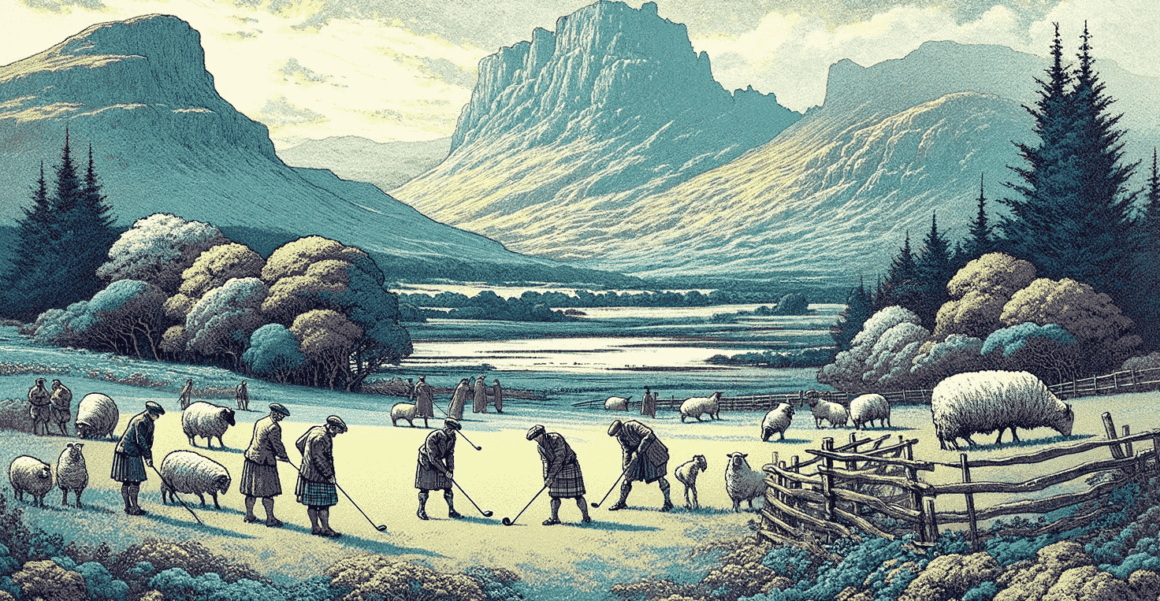When Was Golf Invented? A Brief History
Golf is one of the most popular sports, played by millions around the world, and no matter what the current trends are, it never seems to lose importance. But how did this sport come to be? And when was golf invented?
While most believe that golf began in Scotland in the Middle Ages, there is much debate concerning this issue. In this blog post, we will take a brief look at the history of golf and explore its origins, taking into account the available facts and theories.
The Origins of Golf

According to most reliable sources, the origins of golf date back to eastern Scotland, around Edinburgh. Though the exact details of the game’s beginnings are unclear, it is believed to have originated in the 15th century. The modern game likely evolved from a similar game called chole, which was popular among shepherds.
In chole, players would use a wooden club to hit a stone ball into a hole. Golf probably developed from this game by adding additional holes and eventually switching to a leather-covered ball.
As the game spread among people in the 15th century, many started neglecting their military training, which probably wouldn’t have been that concerning if it wasn’t during a time when the country had to defend itself against an ongoing invasion. This led to King James II banning golf (and football) in 1475.
Although banned, people mostly ignored this rule and continued playing. It was in 1502 when King James IV of Scotland, a golf player himself, decided to officially give the royal seal of approval, lifting the ban and making this game official for the first time since the invention of golf.
With this endorsement, the popularity of golf spread to other European countries during the 16th century. Mary, Queen of Scots, was responsible for introducing the French to the game, and the word ‘caddie’ is a golf term that refers to cadets who were her military aides in France. When it comes to England, King Charles I was the one who brought the game there.
But when did golf become a sport, officially? The rules were written down in 1744, and the first club was formed by the Gentlemen Golfers of Leith, who decided to host an annual tournament with prizes for the winners.
Even though the first reference to what we know today as golf was mentioned in 1552 in St Andrews, the first annual competition with Leith’s rules was not held until 1754. St. Andrews became the first ever premier golf club, and in 1834 got given the title Royal and Ancient” by William IV, King of the United Kingdom of Great Britain and Ireland.
However, other than this widely accepted idea of how golf came to be, there’s data stating that a type of golf was played in today’s Netherlands way back in 1297. The game was played with a leather ball and a stick. The earliest evidence pointing to golf was by a Dutch poet Jacob Merlijn who described a game with the words “with a colf/kolf club.”
Similarly, some historians claimed that golf was played in China way before the Scots. More specifically, Hong Kong curators claimed that the exhibit laid out in 2006 is evidence that ancient Chinese played a sort of golf called “hit ball” way back in 1368. The scroll they claimed to be the evidence shows people hitting the ball near a hole in the ground.
Why Is it Called Golf?
Some believe that the etymological roots of the word “golf” come from the Dutch word kolve or kolf, meaning “club.” However, the early 15th-century Scottish dialect transformed this Dutch word to gouff or goff.
It wasn’t until the 16th century that the word “golf,” as we spell it today, became official. This exchange took place thanks to trading that took place between Scottish and Dutch ports in the period from the 14th to the 17th century.
The Original Golf Rules
Although the existing golf rules consist of more than 34 rules across 200 pages, the initial rules for this sport were summed up in just 13 points. The Gentlemen Golfers of Leigh came up with this set in 1744, calling them the Thirteen Articles.
The first event these rules were implemented in was the first Challenge for the Silver Club played in Scotland. The winner of this tournament was John Rattray, whose signature can be seen on the Thirteen Articles.
Golf Origins: 19th Century Golf Expansion
Since transportation between London and Edinburgh improved in the mid-1800s, a new wave of tourism to Scotland emerged, driven by popular writings by Sir Walter Scott.
Golf was especially appealing to older gentlemen looking for an affordable and less physically challenging sport that would allow them to stay active and involved. As a result, it became one of the most popular sports among this demographic, thanks mainly to the development of the Gutty ball during this time.
The Gutty was a cheap and durable golf ball made from gutta-percha, which offered superior performance and quality compared to other options at the time, such as the original leather & feather balls.
Scottish immigrants, soldiers, and expatriates played a crucial role in spreading golf worldwide in the 18th century. Still, golf gained most of its international fame during the 19th century.
At this time, the expansion of the British Empire took over the world, so the Brits shared their favorite hobbies with those they interacted with. The first golf club was formed outside of Scotland in 1766 (Royal Blackheath), and then the rest of the world followed.
The first golf club outside of Britain was established in Bangalore in 1820. Later on, Royal Curragh in Ireland followed (1856), Adelaide in 1870, Royal Montreal in 1863, and Cape Town in 1885. St Andrews of New York was founded in 1888, and Royal Hong Kong in 1889. By 1880, England already had ten golf courses. This number rose to around 1,000 golf courses by 1914.
The History of Golf Equipment
From the days when the first golfers used a pebble and a stick to play a game on a field that didn’t even remotely resemble a modern golf course, the equipment for this sport evolved steadily. Let’s take a look at the history of golf essentials.
The Timeline of Golf Balls
After playing the game with pebbles and wooden sticks, golfers realized that the game could be improved by developing the equipment – more specifically, the ball. The first balls made for golf contained feathers and leather bags.
The first gutta-percha ball was invented by Adam Paterson in 1848 and couldn’t reach more than 225 yards. A few years later, in 1898, a new model of the ball was introduced by Corburn Haskel. This was the first one-piece rubber core ball and could reach up to 430 yards.
At this time, the balls were mostly smooth, and by the time they got older and more worn out, they could reach longer distances, which led the players to pit them on purpose.
Inspired by Corburn Haskell’s ball, William Taylor was the first person to add the dimple pattern in 1905, setting up the blueprint for how golf balls look today.
Evolution of Golf Clubs
From the days when the first golf clubs were nothing more than wooden shafts, today, we have sophisticated and sturdy clubs made from wood and iron, with enhanced graduation utility, durability, and weight distribution. They developed alongside golf balls, and as one became better, the other soon followed suit.
History of Caddies and Carrying the Equipment
The first golf bags used in this sport appeared during the 1880s. When it comes to caddies who carried the equipment for the players, a popular nickname was “the beast of burden.” A long time after that, when technology became more advanced and cars became more widespread, the first self-propelled golf car was invented in 1962 by Merlin Halvorson.
The Invention of Golf Tees
The first portable golf tee or ball support stand was patented in 1889 by Arthur Douglas and William Bloxsom. It was made from rubber, with three vertical rubber prongs that held the ball. Unlike the modern tees that pierce the ground, these simply lay on the ground.
The tee was first placed on the ground in 1892, thanks to Percy Ellis’ patent. It was called “Perfectum.” Later, in 1897, the “Victor” tee was introduced, with a cup-shaped top. It was patented by Scotsmen PM Matthews and held the ball more firmly.
Key Figures in Golf History
There were 883,500 active golfers only in England in 2020, which shows how alive and well this sport is today.
But golf couldn’t have become what it is today without some of the legends who wrote history and kept it going.
So, let’s look at some of the most influential figures in golf.
Old Tom Morris – One of the first professional golfers, he was born in 1821. He won four Open Championships and is considered one of the pioneers of this sport.
Tom Morris Jr. – Also known as Young Tom Morris, he was the son of Old Tom Morris. He was born in 1851 and won three Open Championships by the time he was only 21. He died tragically young, at the age of 24.
Harry Vardon – A professional golfer from Jersey, born in 1870. He won The Open six times and is one of the members of the World Golf Hall of Fame.
Bobby Jones – One of the most popular golfers in history, was born in 1902. He was a successful amateur golfer and won 13 majors. He is also one of the co-founders of Augusta National Golf Club.
Walter Hagen – One of the greatest players in the first half of the 20th century, he was born in New York and famously won the British Open title and 75 professional tournaments in total. The only title he didn’t win was the Masters – he conquered every other golfing challenge.
Arnold Palmer – Born in 1929, he is one of the most well-known golfers in history. He has won 62 PGA Tour events, including seven majors.
Jack Nicklaus – Also known as The Golden Bear, he was born in 1940. He is considered one of the greatest golfers in history and has won 18 major championships.
Tiger Woods – Born in 1975, he is one of the most successful golfers of all time and one of the wealthiest golf players of all time, with a net worth of $1 billion. He has won 14 majors and is one of the most famous athletes in the world.
Bottom Line
We hope you’ve enjoyed our brief history of golf as presented in this article. From its beginning in Scotland, golf spread across the continents, and these days there’s almost no sport on earth where this sport isn’t played.
As technology improves, so do the techniques for making balls and clubs. The game itself hasn’t changed much (if any) in recent years, though, and the sport has stood the test of time.
FAQ
What does golf mean?
Although some believe that the word ‘golf’ is an acronym, it really isn’t. The word originates from the Dutch word “kolf” or “kolve,” meaning “club.” The Scottish dialect of the 14th and 15th centuries transformed this word to “goff” or “gouff,” and it later became “golf” as we know it today.
When did golf come to America?
Harleston Green is believed to be the first place where an organized golf game took place in America. This area was pastureland near Bitt and Bull streets. It was in 1743 when David Deas, a Charleston merchant, received 432 golf balls and 96 clubs from Scotland. Only five years before that, there was a shipment of golf equipment to the same city, which helped the creation of the South Carolina Golf Club.
Where did golf originate?
Where and when was golf invented, exactly? There are many theories, such as the idea that it might come from the Netherlands or even China. Despite these claims, most experts agree that the origins of the modern sport date back to 15th century Scotland.
What was the first United States golf association?
From the first 18-hole course in the Chicago Golf Club in 1893, golf spread so widely in America that today there are 58 state and regional associations in the US. The first US golf association was formed in New York in 1894. It was later renamed to what we still know it as today: the United States Golf Association.
 BC.Game
BC.Game  BitStarz
BitStarz  Ducky Luck
Ducky Luck  Red Dog Casino
Red Dog Casino